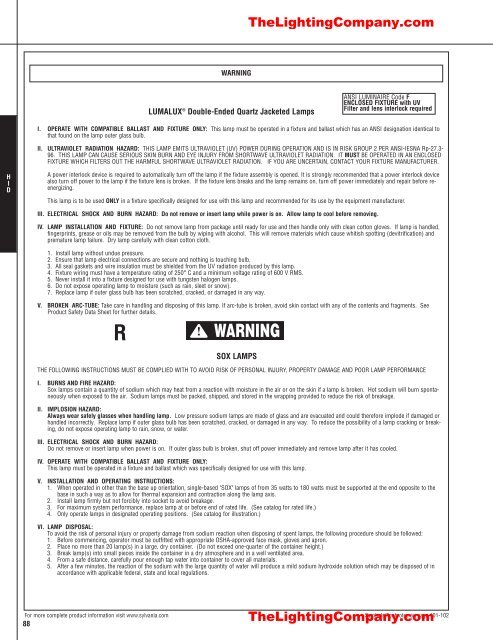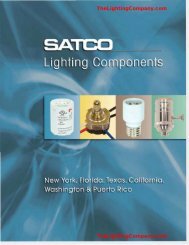Lamp and Ballast Catalog - The Lighting Company
Lamp and Ballast Catalog - The Lighting Company
Lamp and Ballast Catalog - The Lighting Company
- No tags were found...
Create successful ePaper yourself
Turn your PDF publications into a flip-book with our unique Google optimized e-Paper software.
<strong>The</strong><strong>Lighting</strong><strong>Company</strong>.com<br />
WARNING<br />
LUMALUX ® Double-Ended Quartz Jacketed <strong>Lamp</strong>s<br />
ANSI LUMINAIRE Code F<br />
ENCLOSED FIXTURE with UV<br />
Filter <strong>and</strong> lens interlock required<br />
I. OPERATE WITH COMPATIBLE BALLAST AND FIXTURE ONLY: This lamp must be operated in a fixture <strong>and</strong> ballast which has an ANSI designation identical to<br />
that found on the lamp outer glass bulb.<br />
II.<br />
ULTRAVIOLET RADIATION HAZARD: THIS LAMP EMITS ULTRAVIOLET (UV) POWER DURING OPERATION AND IS IN RISK GROUP 2 PER ANSI-IESNA Rp-27.3-<br />
96. THIS LAMP CAN CAUSE SERIOUS SKIN BURN AND EYE INJURY FROM SHORTWAVE ULTRAVIOLET RADIATION. IT MUST BE OPERATED IN AN ENCLOSED<br />
FIXTURE WHICH FILTERS OUT THE HARMFUL SHORTWAVE ULTRAVIOLET RADIATION. IF YOU ARE UNCERTAIN, CONTACT YOUR FIXTURE MANUFACTURER.<br />
H<br />
I<br />
D<br />
A power interlock device is required to automatically turn off the lamp if the fixture assembly is opened. It is strongly recommended that a power interlock device<br />
also turn off power to the lamp if the fixture lens is broken. If the fixture lens breaks <strong>and</strong> the lamp remains on, turn off power immediately <strong>and</strong> repair before reenergizing.<br />
This lamp is to be used ONLY in a fixture specifically designed for use with this lamp <strong>and</strong> recommended for its use by the equipment manufacturer.<br />
III. ELECTRICAL SHOCK AND BURN HAZARD: Do not remove or insert lamp while power is on. Allow lamp to cool before removing.<br />
IV. LAMP INSTALLATION AND FIXTURE: Do not remove lamp from package until ready for use <strong>and</strong> then h<strong>and</strong>le only with clean cotton gloves. If lamp is h<strong>and</strong>led,<br />
fingerprints, grease or oils may be removed from the bulb by wiping with alcohol. This will remove materials which cause whitish spotting (devitrification) <strong>and</strong><br />
premature lamp failure. Dry lamp carefully with clean cotton cloth.<br />
1. Install lamp without undue pressure.<br />
2. Ensure that lamp electrical connections are secure <strong>and</strong> nothing is touching bulb.<br />
3. All seal gaskets <strong>and</strong> wire insulation must be shielded from the UV radiation produced by this lamp.<br />
4. Fixture wiring must have a temperature rating of 250° C <strong>and</strong> a minimum voltage rating of 600 V RMS.<br />
5. Never install it into a fixture designed for use with tungsten halogen lamps.<br />
6. Do not expose operating lamp to moisture (such as rain, sleet or snow).<br />
7. Replace lamp if outer glass bulb has been scratched, cracked, or damaged in any way.<br />
V. BROKEN ARC-TUBE: Take care in h<strong>and</strong>ling <strong>and</strong> disposing of this lamp. If arc-tube is broken, avoid skin contact with any of the contents <strong>and</strong> fragments. See<br />
Product Safety Data Sheet for further details.<br />
R<br />
SOX LAMPS<br />
THE FOLLOWING INSTRUCTIONS MUST BE COMPLIED WITH TO AVOID RISK OF PERSONAL INJURY, PROPERTY DAMAGE AND POOR LAMP PERFORMANCE<br />
I. BURNS AND FIRE HAZARD:<br />
Sox lamps contain a quantity of sodium which may heat from a reaction with moisture in the air or on the skin if a lamp is broken. Hot sodium will burn spontaneously<br />
when exposed to the air. Sodium lamps must be packed, shipped, <strong>and</strong> stored in the wrapping provided to reduce the risk of breakage.<br />
II.<br />
IMPLOSION HAZARD:<br />
Always wear safely glasses when h<strong>and</strong>ling lamp. Low pressure sodium lamps are made of glass <strong>and</strong> are evacuated <strong>and</strong> could therefore implode if damaged or<br />
h<strong>and</strong>led incorrectly. Replace lamp if outer glass bulb has been scratched, cracked, or damaged in any way. To reduce the possibility of a lamp cracking or breaking,<br />
do not expose operating lamp to rain, snow, or water.<br />
III. ELECTRICAL SHOCK AND BURN HAZARD:<br />
Do not remove or insert lamp when power is on. If outer glass bulb is broken, shut off power immediately <strong>and</strong> remove lamp after it has cooled.<br />
IV. OPERATE WITH COMPATIBLE BALLAST AND FIXTURE ONLY:<br />
This lamp must be operated in a fixture <strong>and</strong> ballast which was specifically designed for use with this lamp.<br />
V. INSTALLATION AND OPERATING INSTRUCTIONS:<br />
1. When operated in other than the base up orientation, single-based "SOX" lamps of from 35 watts to 180 watts must be supported at the end opposite to the<br />
base in such a way as to allow for thermal expansion <strong>and</strong> contraction along the lamp axis.<br />
2. Install lamp firmly but not forcibly into socket to avoid breakage.<br />
3. For maximum system performance, replace lamp at or before end of rated life. (See catalog for rated life.)<br />
4. Only operate lamps in designated operating positions. (See catalog for illustration.)<br />
VI. LAMP DISPOSAL:<br />
To avoid the risk of personal injury or property damage from sodium reaction when disposing of spent lamps, the following procedure should be followed:<br />
1. Before commencing, operator must be outfitted with appropriate OSHA-approved face mask, gloves <strong>and</strong> apron.<br />
2. Place no more than 20 lamp(s) in a large, dry container. (Do not exceed one-quarter of the container height.)<br />
3. Break lamp(s) into small pieces inside the container in a dry atmosphere <strong>and</strong> in a well ventilated area.<br />
4. From a safe distance, carefully pour enough tap water into container to cover all materials.<br />
5. After a few minutes, the reaction of the sodium with the large quantity of water will produce a mild sodium hydroxide solution which may be disposed of in<br />
accordance with applicable federal, state <strong>and</strong> local regulations.<br />
<strong>The</strong><strong>Lighting</strong><strong>Company</strong>.com<br />
For more complete product information visit www.sylvania.com Symbols/Footnotes on page 101-102<br />
88




